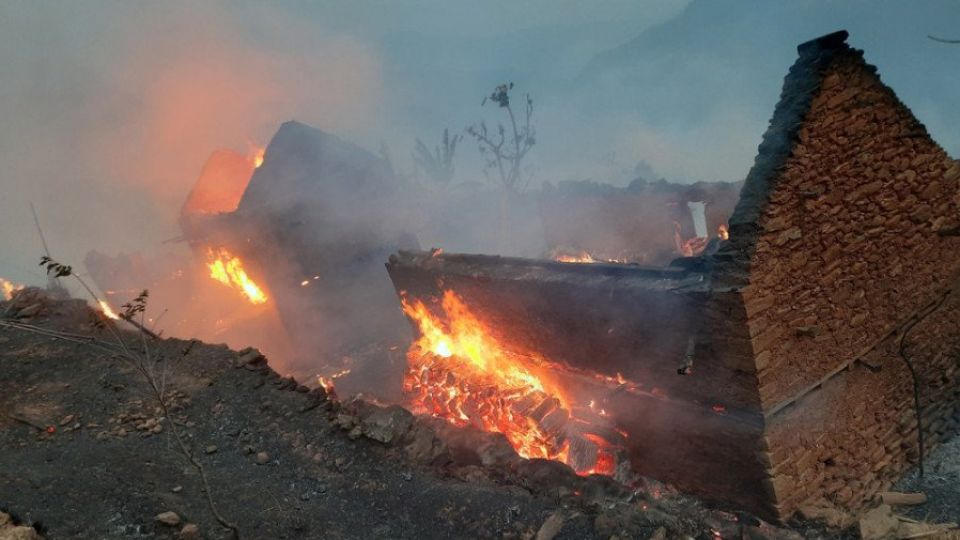February 27, 2023
KATHMANDU – On Friday, two children aged four and five years were killed in a house fire in Hilihang Rural Municipality-7 of Panchthar district. Parents of the victims had reportedly gone to their farms at the time the fire broke out.
Fourteen houses were engulfed in a fire in Terhathum the same day.
Nepal Army medevaced two fire victims—one 19 and another 21 years old—on Saturday to Kathmandu from Surkhet. Around 80 percent of the body of one of the victims had been burnt and 36 percent of another, according to media reports.
Fire incidents in Nepal have been on the rise.
At least 75 incidents have been recorded throughout the country over the last week, according to the National Disaster Risk Reduction and Management Authority. Thirty people—20 females and 10 males—have lost their lives in fire incidents since the start of 2023. According to the authority, 108 others have been injured, 764 families affected and properties worth Rs381,219,945 destroyed in fire-related incidents in the past two months.
In 2022, 106 people—39 male and 67 female—died, and 369 others were injured while 3,022 families were affected as properties worth more than Rs 2.577 billion perished in 2,595 fire-related incidents.
“The season of forest fires has just started,” said Dhruba Bahadur Khadka, spokesperson for the authority. “As the mercury rises and rainfall has not happened in the past several months, the number of fire incidents could rise throughout the country in the coming days. Therefore, we urge all to be careful.”
Nepal has received no rain since early October. Meteorologists say there is no weather system in sight to cause significant rainfall immediately.
Dry conditions and higher temperatures increase the likelihood of fire incidents. “The dry season has extended in Nepal and that’s a fact,” said Bhushan Tuladhar, an environmentalist. “This has not only increased fire incidents, it also poses a serious threat to human life and property as well as to wildlife.”
Wildfires usually start from March in Nepal, when farmers burn the remains of crops on the fields and the threat keeps growing until April-May, depending on precipitation. Thousands of incidents of fire are witnessed throughout the country during that time and not all of them go into government records.
“Incidents of fire have just started. More incidents could happen this year, as the country has had a prolonged dry spell,” said Bhupendra Das, an air quality expert at Clean Air Asia, an international non-governmental organisation leading a regional mission for better air quality, and healthier, more livable cities. “Wildfires or forest fires not only cause loss of lives and properties, they also inflict damage to the environment and ecology.”
On Saturday, Kathmandu ranked 10th among the most polluted cities in the world. The Kathmandu Valley’s air quality index reached 173 in the afternoon. As per the United States Environment Protection Agency’s air quality index, when air pollutant PM2.5 reaches 151 to 200 μg/m3, the air quality is considered unhealthy; everyone may experience problems, with sensitive groups experiencing more severe effects.
Construction of artificial ponds—which not only helps in dousing fires but also provides drinking water to animals; launching awareness on the risks of open burning, controlled burning and intentional burning of fire; arranging for fire-fighting equipment and strengthening local and provincial authorities to control blazes are among the measures authorities could take to lessen the losses.
Authorities have made some efforts to lessen the losses from fire incidents, but the measures are not sufficient and more could have been done, experts say.
Meanwhile, the National Disaster Risk Reduction and Management Authority has sent four portable water pumps to local governments and is preparing to distribute 14 additional pumps. Those pumps can draw water from 1,500 metres depth and pump it 300 metres away.
“We have urged all local units to purchase this type of water pump, which can be used at the time of a fire emergency,” said spokesperson Khadka.


